Hot Rod Reunion Sparks Flame Nostalgia
Annual Bakersfield Drag Race Gathering
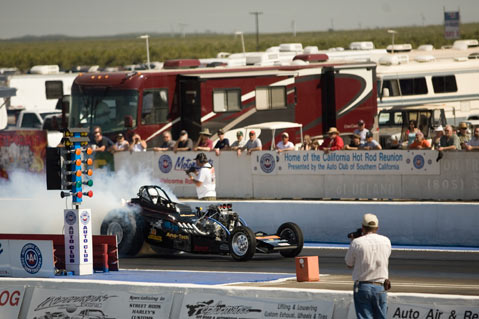
The originators of the reunion thought the first event in 1991 would be a one-time deal, and were satisfied when a few thousand people came to see about 200 old-style front-engine cars. But the “Geezer Reunion”-which now happens every fall at the Auto Club Famoso Raceway north of Bakersfield-has exploded into a major racing event, attracting 50,000 fans and racers from all over the United States and Canada. It’s a reunion in the classic sense of the word; everywhere you turn, there are groups of silver-haired seniors, many with pot bellies, reminiscing about the raves and cars from ’62 and before.
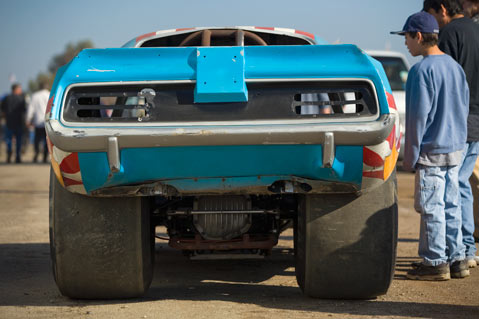
Most of the legendary drag strips where these heroes streaked down the quarter-mile have long ago succumbed to the bulldozer and are covered over with malls and subdivisions. But at Famoso, their memories are alive: The long-dead racetracks’ names can still be seen on T-shirts and jackets and overheard in conversations. In the north, we raced on drag strips in Fremont and Half Moon Bay. In the south, there was Lions and San Fernando. But of all places, Santa Barbara had the first organized drag races back in the 1940s on a landing strip where the airport is now.
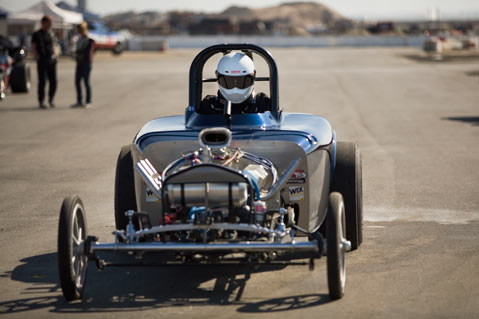
The technology was basic back in the day, and here in S.B., it is said, the winner was decided by whoever went over a bump in the pavement at the end of the quarter mile. Until the ’60s, the race was started by a flagman who jumped in the air with his own acrobatic style. Today, races are started electronically by “Christmas Tree” lights, but at least there still needs to be a human at the starting line to push the button. And some ways of old still persist-at Famoso in October, the 25,000 or so who packed the grandstands on Saturday were protected from the racing cars just by the hay bales that lined the sides of the track.
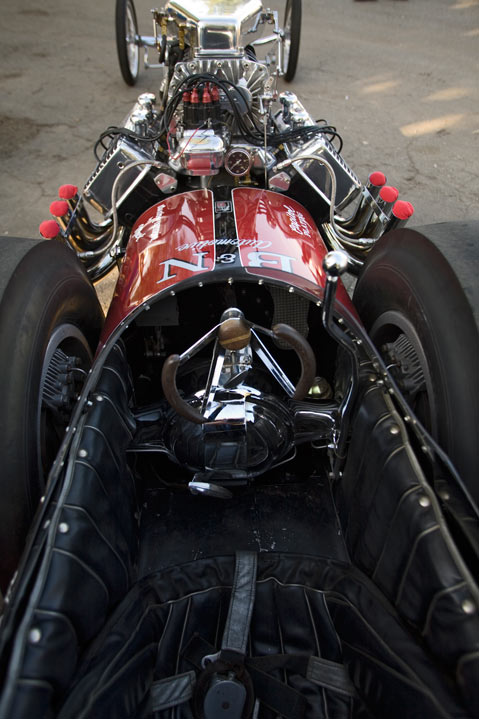
As with all reunions, this one’s powered by personality. Don “Big Daddy” Garlits was there, with a lovingly restored “Swamp Rat VIII” from his Museum of Drag Racing in Ocala, Florida. Big Daddy has come a long way from his first trip to Famoso in 1959 for the U.S. Fuel and Gas Championships, when he was lured out here by the huge (in those days) $1,000 prize. He hauled his first cobbled-together dragster out here on an open trailer behind his brother Ed’s 1953 Buick, and was roundly jeered as a “grease monkey.” Race fans threw so many beer cans at him that his brother had to clear a path for the car through the pits. Hometown heroes Art Chrisman and Cary Cagle made passes at 180 mph, and fans went wild. The announcer asked, “How’d you like that Tampa Dan?” which he was called back then. Don hated it, and his mood only got worse when his engine blew at the starting line, forcing him to retreat to Florida in defeat. Resentment from his harsh treatment here fueled feverish work to improve the car, and Big Daddy went on to set many records and eventually even beat the California boys. Garlits’s trip in 2007 was quite a contrast from his first journey-this time he was with his wife, Pat, in a custom semitruck car hauler/motor home, and was revered as a drag racing legend.
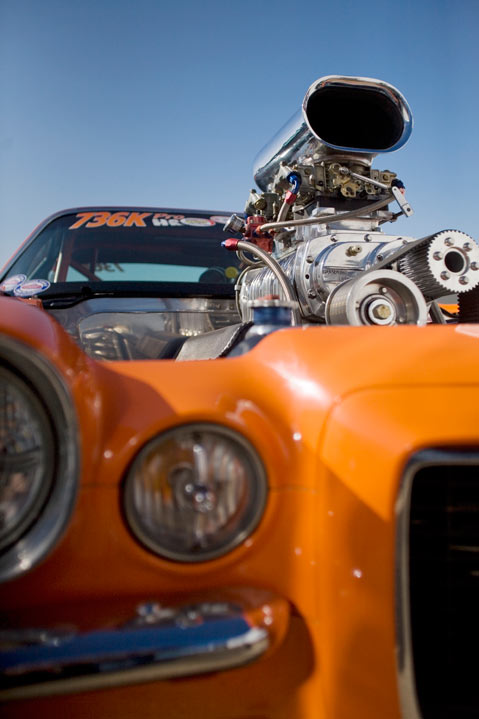
The pits at Famoso were filled with shiny custom semitrucks that haul several cars, and contain complete high-tech shops to work on the race cars. There was also a virtual sea of quarter-million-dollar motor homes. Wandering through the pits, you could smell delicious BBQ aromas as the crews cooked for mechanics, drivers, wives, and kids. Working on the cars becomes a spectator sport, too, as friends and family of each crew sit around in lawn chairs and share in the sometimes desperate drama of rebuilding a whole engine before the call to staging lanes sounds for the next round of racing. A strong spirit of cooperation coexists with an intense competitive attitude as parts, fuel, and sometimes transmissions are loaned back and forth, and even to opposing crews.
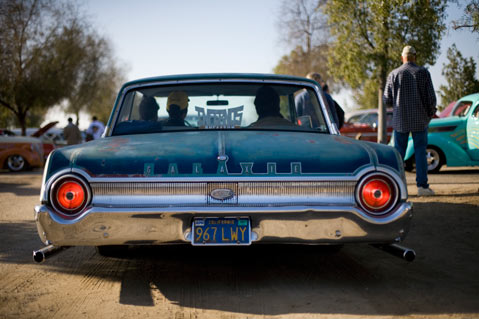
The vintage cars that race include several types, but they are all updated to National Hot Rod Association safety standards, allowing these cars to attain speeds unheard of back in the day. There are also old race cars run for exhibition only, many of which have been hidden away in garages or barns for 20 or 30 years and have only recently been resurrected by their third or fourth owner. Great pains are taken to track down original parts so the cars will be faithfully authentic.
Some, like the Swamp Rat and TV Tommy Ivo’s Brainstormer, are legendary racers, and some are plain impressive, like Ivo’s four-engine car that was the glittering centerpiece of the DoubleTree’s lobby. On Saturday evening, the Northwind, Hustler, Poison Ivy, and about 50 more exhibition cars were called to the staging lanes for what is called a “cackle fest,” named after the sound of the crackling individual exhaust headers. Though they don’t meet today’s safety standards, these cars have been restored to even more pristine condition than when they originally raced. The cars fire up their engines on the strip and are left cackling to the appreciative cheers of the crowd. The smiles on some of the graybeards sitting in the cockpits tell the whole story and the sparkle in their eyes reveal the pride these old-timers have in their cars. One can only imagine the memories of wild trips down the racetrack long ago. This is the annual reward for all the hours and money spent painstakingly resurrecting these legendary race cars.
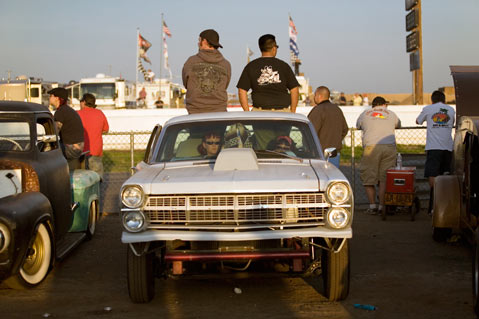
Top speeds of 180 mph were posted at the first U.S. Fuel & Gas Championships at Famoso back in 1959, but today’s Nostalgia Top Fuel cars-powered by supercharged, fuel-injected, 1,800-horsepower engines-hit 250 mph and cover the quarter mile in just over five seconds. By way of comparison, an average passenger car going about 80 will take 19 seconds to finish the quarter mile. Standing behind the starting line as a race begins is a truly amazing experience-the cars rev up, the slick tires dig for traction and distend, and then the car rapidly vanishes down the track until the parachute pops open down past the finish.
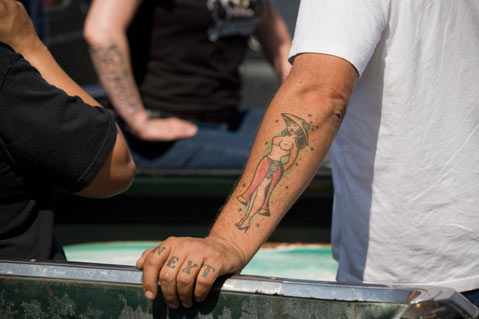
The Hot Rod Reunion also features a big street rod car show for pre-1972 cars that are parked near the drag strip, a vendor’s midway displaying new parts and hot rod retro-fashion clothing, and a swap meet selling everything from whole cars to wheels. The Kar Kulture and Rat Rod phenomenon also was well represented, which includes early-style hot rods that are usually unpainted, some 1950s fashion, and plenty of tattoos.
By the time the reunion wound down on Sunday afternoon, there were top place finishers and those that came in second. But the racers and fans alike all finished first, because they’d participated in the celebration of hot rod history.



